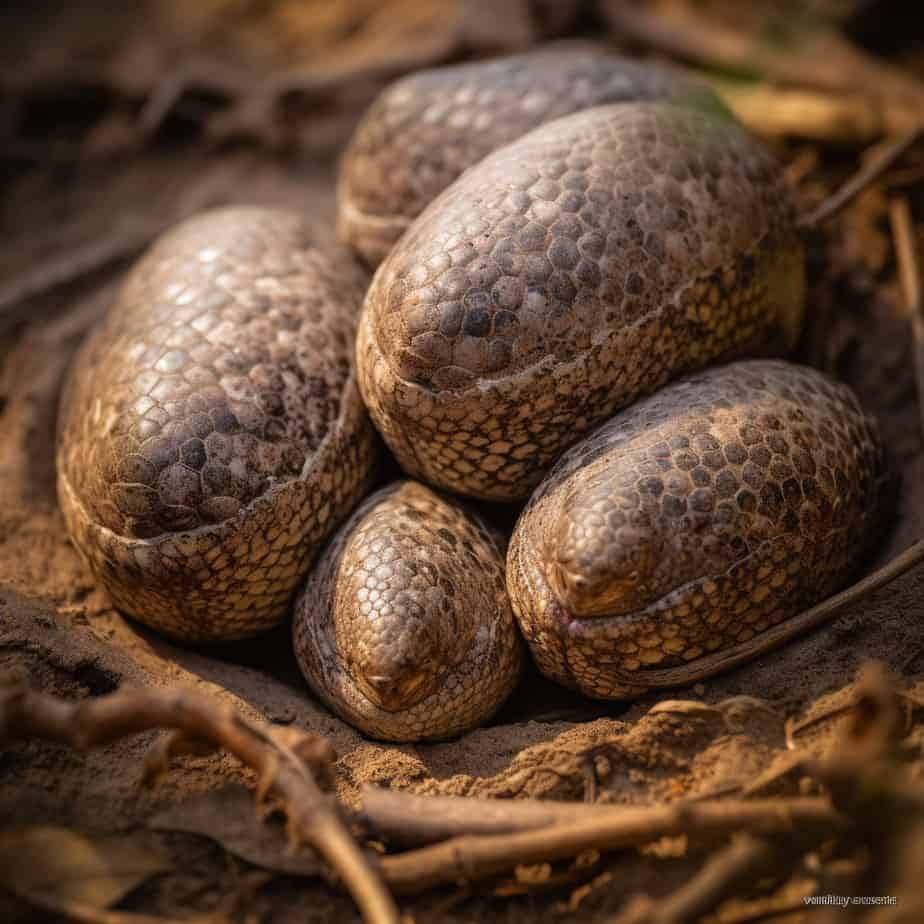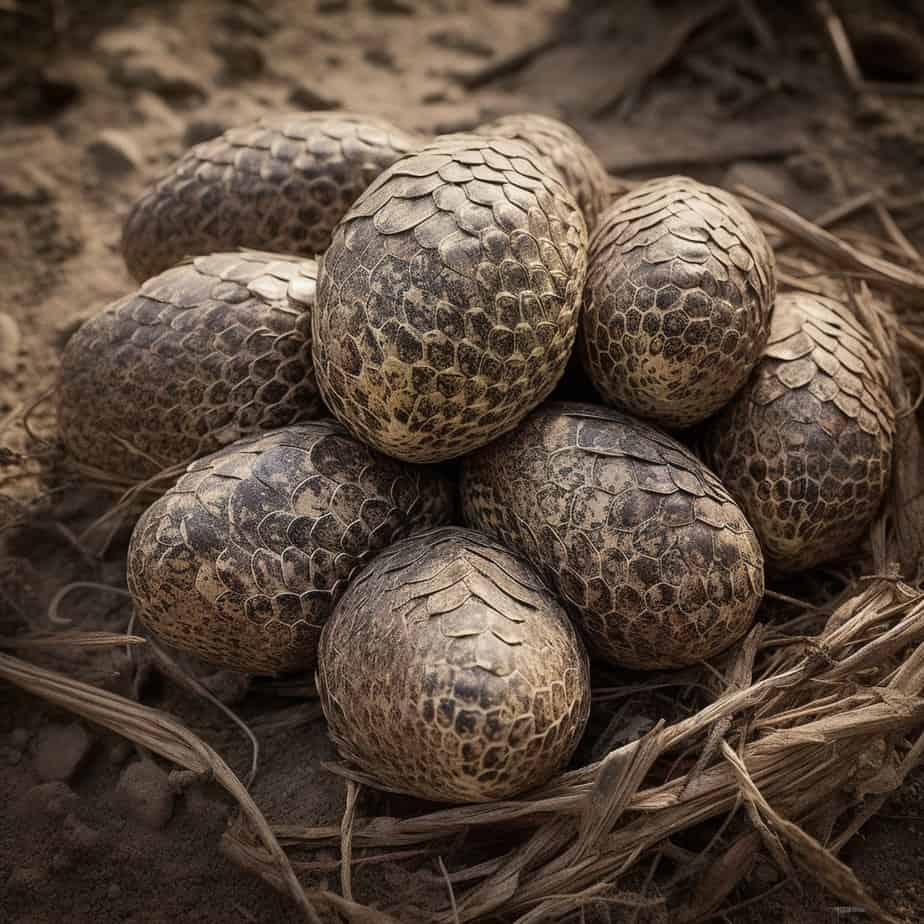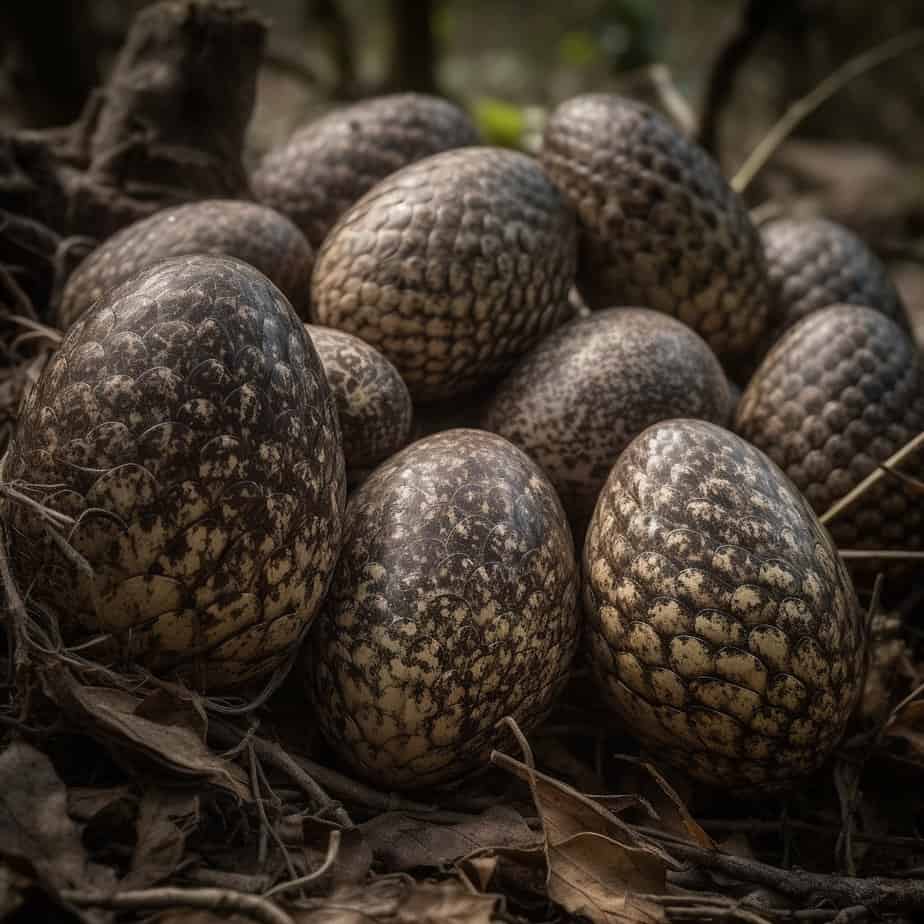Komodo dragons are fascinating creatures that are native to the Indonesian islands of Komodo, Rinca, Flores, Gili Motang, and Padar. These magnificent reptiles are known for their impressive size, powerful jaws, and venomous bite. However, one aspect of their life cycle that often goes unnoticed is their reproduction, specifically the process of laying and incubating their eggs. In this article, we will delve into the world of Komodo dragon eggs, exploring how they are laid, incubated, and the challenges faced by these remarkable reptiles during this crucial stage of their life cycle. So, let’s embark on a journey to discover the incredible world of Komodo dragon eggs.
Key Takeaways
- Komodo dragon eggs are laid in nests dug by the female Komodo dragon.
- The temperature of the nest determines the sex of the hatchlings.
- Female Komodo dragons can reproduce without a male through a process called parthenogenesis.
- The incubation period for Komodo dragon eggs is around 7-8 months.
- Hatchlings are vulnerable to predation and cannibalism from adult Komodo dragons.
The Fascinating World of Komodo Dragon Eggs
A. What Do Komodo Dragon Eggs Look Like?
Komodo dragon eggs are truly remarkable in their appearance. These eggs have a unique texture and color that make them easily distinguishable from other reptile eggs. When you come across a Komodo dragon nest, you will notice that the eggs are oval-shaped and have a leathery shell. The shell is rough and has a slightly bumpy texture, which helps protect the developing embryos inside.
The color of Komodo dragon eggs can vary, but they are typically a pale, creamy white. This coloration allows the eggs to blend in with the surrounding environment, providing camouflage and protection from potential predators. It’s fascinating to think about how these eggs have evolved to ensure the survival of the species.
B. How Big Are Komodo Dragon Eggs?
Komodo dragon eggs are relatively large compared to the eggs of other reptiles. On average, they measure around 8 to 10 centimeters in length. This size is quite impressive considering that Komodo dragons themselves are the largest lizards in the world. The size of the eggs is proportional to the size of the adult female Komodo dragons, which can grow up to 10 feet long and weigh over 150 pounds.
The large size of Komodo dragon eggs is essential for the successful development of the embryos inside. It provides them with enough space to grow and develop before hatching. It’s incredible to think about the journey these tiny creatures go through inside their eggs before emerging into the world.
C. Are Komodo Dragon Eggs Hard?
While Komodo dragon eggs may appear hard due to their rough texture, they are actually quite soft compared to the eggs of other reptiles. The leathery shell of the eggs provides some flexibility, allowing them to withstand the weight of the nesting female and any potential impacts or pressure.
The softness of the eggs is crucial for the survival of the developing embryos. It allows them to absorb oxygen from the surrounding environment, ensuring proper respiration. Additionally, the soft shell makes it easier for the hatchlings to break through and emerge from the eggs when the time comes.
It’s important to note that despite their relative softness, Komodo dragon eggs are still delicate and require protection. The nesting female carefully selects the nesting site and buries the eggs to shield them from predators and environmental factors. This maternal behavior highlights the remarkable instincts and care exhibited by Komodo dragons.
In conclusion, Komodo dragon eggs are truly fascinating. Their unique appearance, size, and texture contribute to the survival and development of these incredible creatures. Understanding the characteristics of Komodo dragon eggs provides valuable insights into the life cycle and reproductive strategies of this endangered species.
The Reproductive Cycle of Komodo Dragons

A. How Many Eggs Does a Komodo Dragon Lay?
Komodo dragons, scientifically known as Varanus komodoensis, are fascinating creatures that belong to the reptile family. When it comes to reproduction, female Komodo dragons lay a significant number of eggs. On average, a female Komodo dragon can lay anywhere between 20 to 30 eggs in a single clutch. However, it is not uncommon for them to lay even more eggs, with some females producing up to 40 eggs in a single breeding season.
B. Where Do Komodo Dragons Lay Their Eggs?
After the female Komodo dragon has laid her eggs, she carefully selects a suitable nesting site. These reptiles prefer to lay their eggs in sandy soil or loose volcanic ash, as these materials provide optimal conditions for incubation. The nesting sites are typically located in the open, away from dense vegetation, to ensure the eggs receive ample sunlight and warmth.
Komodo dragons exhibit a strong maternal instinct, and they take great care in selecting the perfect spot for their eggs. They often dig deep burrows in the ground, measuring up to 1 meter (3.3 feet) in depth, to create a safe and secure environment for their developing offspring. This behavior helps protect the eggs from predators and extreme weather conditions.
C. Komodo Dragon Egg Laying: An Intricate Process
The process of Komodo dragon egg laying is a fascinating and intricate one. After the female has chosen a suitable nesting site, she begins to lay her eggs one by one. The eggs are elongated and have a leathery texture, similar to other reptile eggs.
Once the eggs are laid, the female carefully covers them with soil, using her powerful hind legs to ensure they are well-hidden and protected. This behavior is crucial for the survival of the eggs, as it helps to camouflage them from potential predators.
After the eggs are buried, the female Komodo dragon leaves the nesting site and does not provide any further parental care. The eggs are left to incubate for approximately 7 to 8 months. During this time, the eggs rely on the surrounding environmental conditions, such as temperature and humidity, for their development.
It is worth noting that Komodo dragon eggs face numerous challenges during the incubation period. The eggs are vulnerable to predation by other animals, such as monitor lizards and snakes, as well as the risk of being damaged by natural elements like flooding or extreme temperatures.
In conclusion, the reproductive cycle of Komodo dragons is a remarkable process. Female Komodo dragons lay a substantial number of eggs, which they carefully bury in secure nesting sites. The eggs then undergo a period of incubation, relying on the surrounding environment for their development. This intricate process highlights the resilience and adaptability of these magnificent creatures.
The Journey of Komodo Dragon Eggs: From Laying to Hatching

A. Komodo Dragon Egg Nest: A Safe Haven
When it comes to reproduction, Komodo dragons have a unique and fascinating process. Female Komodo dragons, known as “sows,” lay their eggs in carefully constructed nests. These nests serve as a safe haven for the precious eggs, protecting them from potential predators and providing an optimal environment for incubation.
The nesting process begins with the female Komodo dragon digging a hole in the ground using her powerful claws. She carefully selects a suitable location, often in sandy soil or decaying vegetation, where the eggs can be buried and hidden from sight. The depth of the nest can vary, but it is typically around 1 to 2 meters deep.
Once the hole is ready, the female lays her eggs, which are usually oblong in shape and have a leathery texture. The number of eggs in a clutch can range from 15 to 30, depending on the size and age of the female. After laying the eggs, the female covers them with soil and vegetation, effectively camouflaging the nest.
B. Komodo Dragon Egg Incubation: A Waiting Game
After the eggs are laid, the incubation period begins. Komodo dragon eggs have a relatively long incubation period, lasting around 7 to 8 months. During this time, the eggs are left unattended by the mother, as she does not provide any further care or protection.
The incubation temperature plays a crucial role in determining the sex of the hatchlings. Komodo dragons exhibit temperature-dependent sex determination, meaning that the temperature at which the eggs are incubated determines whether the offspring will be male or female. Higher temperatures generally result in male hatchlings, while lower temperatures produce females.
The nest provides a stable environment for the eggs, with the surrounding soil acting as a natural incubator. The heat from the sun and the decomposition of organic matter in the soil contribute to maintaining a suitable temperature range for incubation. The exact mechanisms by which the eggs develop and hatch remain a subject of scientific research.
C. Komodo Dragon Eggs Hatching: A New Beginning
After months of waiting, the momentous occasion arrives – the hatching of the Komodo dragon eggs. The hatchlings use a specialized tooth, known as an “egg tooth,” to crack open their shells. This tooth is a temporary structure that falls off shortly after hatching.
The hatchlings emerge from the nest and begin their journey into the world. At this stage, they are vulnerable and rely on their instincts to survive. They are miniature versions of their adult counterparts, measuring around 40 to 50 centimeters in length and weighing just a few hundred grams.
Young Komodo dragons face numerous challenges as they navigate their surroundings. They must avoid predators, find food, and establish their territories. Only a small percentage of hatchlings will reach adulthood, as they face threats from larger predators, scarcity of resources, and other environmental factors.
Komodo dragon eggs and the entire reproductive process play a vital role in the survival of this endangered species. Conservation efforts, such as those implemented in Komodo National Park in Indonesia, aim to protect the habitat and ensure the long-term survival of these remarkable creatures.
In conclusion, the journey of Komodo dragon eggs is a remarkable process that highlights the resilience and adaptability of these fascinating reptiles. From the careful construction of the nest to the hatching of the eggs, each step in the lifecycle of Komodo dragons contributes to the survival of this endangered species. By understanding and appreciating the intricacies of their reproduction, we can better protect and conserve these magnificent creatures for generations to come.
The Survival of Komodo Dragon Eggs
A. How Many Komodo Dragon Eggs Survive?
The survival of Komodo dragon eggs is a critical aspect of the species’ lifecycle. Female Komodo dragons lay their eggs in carefully constructed nests, where they are left to incubate. However, the journey from egg to hatchling is fraught with challenges, and not all eggs make it to the hatching stage.
Komodo dragon eggs face numerous threats during their incubation period. Natural predators, such as monitor lizards and snakes, pose a significant risk to the survival of the eggs. These predators are attracted to the scent of the eggs and can easily locate and devour them if not adequately protected.
Additionally, environmental factors play a role in determining the survival rate of Komodo dragon eggs. Temperature and humidity levels within the nest can greatly impact the development of the embryos. If the conditions are not optimal, the eggs may fail to hatch or produce weak and unhealthy hatchlings.
It is estimated that only around 50% of Komodo dragon eggs successfully hatch and survive to become juveniles. This relatively low survival rate highlights the challenges faced by these remarkable reptiles in their early stages of life.
B. Do Komodo Dragons Eat Their Eggs?
While it may seem counterintuitive, Komodo dragons do not typically eat their own eggs. Unlike some reptiles, such as snakes, which may consume their eggs for nutrition, Komodo dragons exhibit a different behavior when it comes to their eggs.
Female Komodo dragons invest a significant amount of time and effort in constructing their nests and laying their eggs. Once the eggs are laid, the female will carefully cover the nest to protect it from predators and the elements. She will then leave the nest and play no further role in the incubation or care of the eggs.
C. Komodo Dragon Eating Eggs: A Survival Strategy
The absence of maternal care may seem like a disadvantage for the survival of Komodo dragon eggs, but it is actually a survival strategy. By not lingering around the nest, the female avoids drawing attention to the eggs and reduces the risk of predation.
Furthermore, the female’s departure from the nest allows her to focus on her own survival. Komodo dragons are solitary creatures and must fend for themselves in their harsh and competitive environment. By prioritizing their own survival, female Komodo dragons can ensure their ability to reproduce in the future.
The survival strategy of Komodo dragons relies on the natural environment to provide the necessary conditions for egg incubation. The eggs are left to develop and hatch without any parental guidance. This strategy may seem risky, but it has been successful for millions of years, allowing the Komodo dragon species to persist and adapt to its unique habitat.
In conclusion, the survival of Komodo dragon eggs is a complex process influenced by various factors. While only about half of the eggs successfully hatch, the absence of maternal care and the reliance on natural incubation are key elements of the species’ survival strategy. Understanding the challenges faced by Komodo dragon eggs is crucial for conservation efforts aimed at protecting this endangered species and its unique reproductive cycle.
The Curious Case of Komodo Dragon Eggs in Human Culture

A. Komodo Dragon Eggs Edible: A Myth or Reality?
The Komodo dragon, also known as Varanus komodoensis, is a fascinating creature that has captured the curiosity of humans for centuries. One of the most intriguing aspects of these giant lizards is their reproductive process, which includes the laying of eggs. While the primary purpose of Komodo dragon eggs is to ensure the survival of the species, they have also sparked interest in human culture, particularly when it comes to their edibility.
There is a common myth that suggests Komodo dragon eggs are edible and can be consumed by humans. However, this notion is far from reality. In fact, consuming Komodo dragon eggs can be extremely dangerous and potentially fatal. The eggs of these reptiles contain bacteria that can cause severe infections in humans, leading to serious health complications.
The misconception surrounding the edibility of Komodo dragon eggs may stem from the fact that eggs are a common food source for many animals in the wild. Predators such as monitor lizards, snakes, and birds often prey on the eggs laid by Komodo dragons. This natural behavior might have led some to believe that the eggs are safe for human consumption. However, it is important to remember that animals have different digestive systems and immune responses than humans, making their ability to safely consume these eggs irrelevant to our own health.
B. Komodo Dragon Egg BBQ: A Controversial Delicacy
While it is clear that consuming Komodo dragon eggs is not advisable, there have been instances where these eggs have been used in culinary experiments. In some regions, particularly in Indonesia where the Komodo dragon is native, there have been reports of Komodo dragon egg BBQ being served as a controversial delicacy.
It is crucial to note that the consumption of Komodo dragon eggs for culinary purposes is highly controversial and frowned upon by conservationists and wildlife experts. The Komodo dragon is an endangered species, and any form of exploitation, including the consumption of their eggs, can further endanger their population.
The Indonesian government, along with various conservation organizations, has implemented strict regulations to protect the Komodo dragon and its habitat. These regulations prohibit the hunting, trading, and consumption of Komodo dragon eggs. Violators can face severe penalties, including imprisonment and hefty fines.
C. Komodo Dragon Egg Price: The Cost of Rarity
Due to the rarity and protected status of Komodo dragon eggs, they have become highly sought after by collectors and enthusiasts. The illegal trade of these eggs has created a black market where individuals are willing to pay exorbitant prices to acquire them.
The price of Komodo dragon eggs can vary significantly depending on various factors, including their size, condition, and legality. On the black market, a single Komodo dragon egg can fetch prices ranging from several hundred to several thousand dollars. The high price tag is a testament to the rarity and allure associated with these eggs.
However, it is crucial to emphasize that participating in the illegal trade of Komodo dragon eggs not only supports the endangerment of the species but also contributes to the destruction of their natural habitat. It is essential for individuals to prioritize the conservation and protection of these magnificent creatures rather than indulging in the illicit trade of their eggs.
In conclusion, while Komodo dragon eggs may hold a certain fascination in human culture, it is important to approach them with caution and respect. They are not edible for humans, and their consumption can have severe health consequences. Additionally, the illegal trade of these eggs poses a significant threat to the survival of the Komodo dragon species. It is crucial for individuals to prioritize the conservation and protection of these magnificent creatures, ensuring their existence for future generations to admire and appreciate. Conclusion
In conclusion, the eggs of the Komodo dragon are a fascinating aspect of their reproductive cycle. These large reptiles lay their eggs in underground nests, providing a safe and warm environment for the development of the embryos. The incubation period lasts for several months, during which the mother dragon guards the nest and ensures the eggs remain protected. Once hatched, the baby Komodo dragons are left to fend for themselves, facing numerous challenges in their quest for survival. The conservation efforts aimed at protecting these incredible creatures and their eggs are crucial for the long-term survival of the species. By understanding and appreciating the unique characteristics of Komodo dragon eggs, we can contribute to the conservation of these magnificent reptiles and the fragile ecosystems they inhabit.
Frequently Asked Questions
How many eggs does a Komodo dragon lay?
Komodo dragons, on average, lay about 20 to 30 eggs at a time. However, this can vary depending on the individual and environmental conditions.
Are Komodo dragon eggs edible?
No, Komodo dragon eggs are not edible. They are protected by law as Komodo dragons are an endangered species. Consuming or trading their eggs is illegal and unethical.
What is unique about a Komodo dragon egg nest?
Komodo dragons display unique maternal behavior. The female Komodo dragon digs a nest in the earth where she lays her eggs and then covers them with soil and vegetation. She then guards the nest for a period of time to protect the eggs from predators.
Can you share some Komodo dragon egg facts?
Komodo dragon eggs are quite large, about the size of a grapefruit. They have a hard shell and the incubation period is approximately 7-8 months. The hatchlings are fully independent from birth.
How does the Komodo dragon egg laying process work?
The female Komodo dragon, after mating, digs a nest where she lays her eggs. She then covers the nest with soil and vegetation to protect it from predators. This is a unique example of maternal behavior in egg-laying reptiles.
What is the size of a Komodo dragon egg?
Komodo dragon eggs are quite large, about the size of a grapefruit. This makes them one of the largest lizard eggs in the world.
Do Komodo dragons eat their own eggs?
While it is not common, some Komodo dragons have been observed eating their own eggs. This behavior is generally associated with stress or a lack of food resources.
What is the incubation period for a Komodo dragon egg?
The incubation period for a Komodo dragon egg is approximately 7-8 months. The eggs are usually laid in August and hatch around April of the following year.
Where do Komodo dragons lay their eggs?
Komodo dragons lay their eggs in nests that they dig in the earth. These nests are typically located in secluded areas to protect them from predators. The Komodo National Park in Indonesia is a common place to find these nests.
How many Komodo dragon eggs usually survive?
The survival rate of Komodo dragon eggs is quite low due to predation and environmental factors. On average, only about 10% of the eggs laid will survive to hatch. Conservation efforts are ongoing to protect this endangered species and increase their survival rate.




